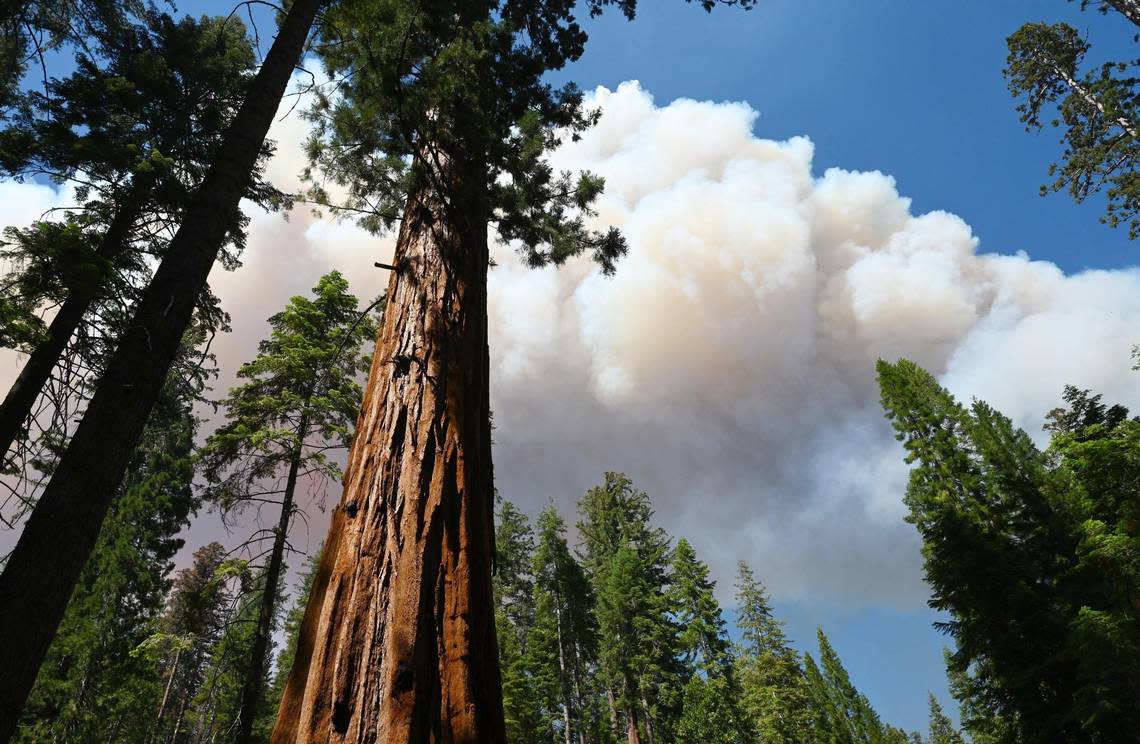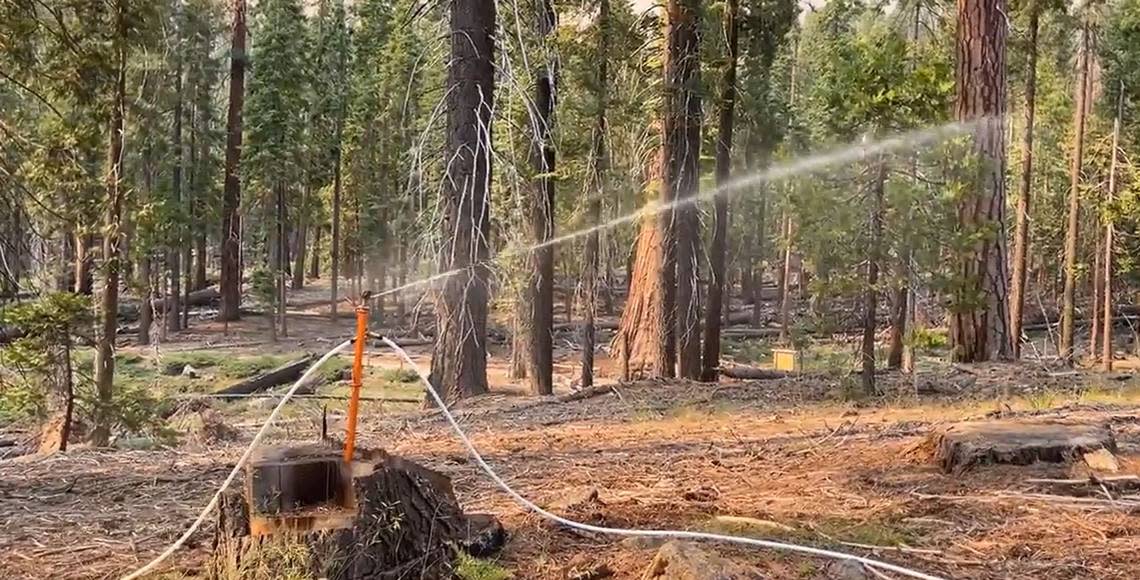Yosemite wildfire update: How does 3,800-acre Washburn Fire rank compared to other fires?
When it comes to huge wildfires that California has experienced just since 2020, the Washburn Fire now burning in Yosemite National Park is relatively small potatoes.
The fire’s global profile, however, has been magnified by its proximity to the park’s Mariposa Grove, a stand of hundreds of mature giant sequoia trees that, in some cases, have survived for millennia.
The fire began on the afternoon of July 7 on the Washburn Trail within the Mariposa Grove.
One of the top priorities for the hundreds of firefighters working to contain the wildfire is ensuring that the iconic giants remain undamaged by flames.
Concern over the fate of the trees can be traced to large-scale, high-intensity California wildfires that, over the past couple of years, have destroyed a sizable share of the world’s giant sequoia trees, which grow in a relatively narrow geographic realm in the Sierra Nevada range east of the San Joaquin Valley.
“There are estimates that between 15% and 18% of the monarch giant sequoias – those that are 4 feet in diameter or larger, have died just within the last 20 months,” Malcolm North, a research scientist with the U.S. Forest Service, told The Fresno Bee in a phone interview on Tuesday.
North, who is also an affiliate professor in the Department of Plant Science at the UC Davis, noted that giant sequoias are among the most fire-resistant trees on the planet. “It’s just built for fire,” North said. “Sequoias have this fibrous bark that is several feet thick. It’s perfect insulation.”

So even though the Washburn Fire is less than 25% contained, North said there seems to be relatively small reason for worry now about the demise of the sequoias in Mariposa Grove.
That’s a sharp contrast to the Windy Fire and KNP Complex that ravaged parts of Sequoia and Kings Canyon National Parks and the Sequoia National Forest in eastern Tulare County, including several groves of giant sequoia trees, in the summer and fall of 2021.
A small fire by comparison
At an estimated 3,772 acres in size as of Wednesday morning, the Washburn Fire pales in comparison to not only the 98,000-acre Windy Fire and the 88,000-acre KNP Complex, but also to some of the largest wildfires recorded in California over the past 90 years.
In fact, it’s not even the largest wildfire so far this year in the state.
“I understand why people get very worried about fire in sequoia groves, but if you get the right kind of fire, it actually improves the health of the forest by reducing the density, reducing the fuel loads,” North said. “It can be a real benefit to the sequoias themselves.”
“It’s just that at some point, either with high fuel loads or extreme weather, you get past a tipping point and start killing some of the trees you want to hold onto,” he added.
Weather conditions so far during the Washburn Fire, while featuring high temperatures, have also included relatively calm winds. “When I looked at the weather (in Yosemite), it didn’t raise any extreme alarm bells to me,” North said.
Much of the mortality among the monarch sequoias is related to wildfires that burned with an intensity generated by either abundance of fuel – either dead standing or downed trees and lots of dry needles and other debris on the forest floor in sequoia groves – or extreme weather, or both.
Managing the Mariposa Grove
Recent years of drought and weakened trees in the Sierra Nevada range on the east flank of Central California’s San Joaquin Valley are among the concerns for firefighters. “Significant tree mortality from 2013-2015 has left significant dead standing and dead fallen fuels,” according to incident commanders with an interagency fire management team.
“This also presents significant safety hazards to firefighters.”
The Mariposa Grove is the largest stand of massive giant sequoias in Yosemite, with more than 500 mature specimens of the iconic trees. The grove was the first area of what is now Yosemite National Park when President Abraham Lincoln signed legislation in 1864 to protect Mariposa Grove.
Flames from the Washburn Fire did move through parts of the grove over the weekend, but they did not burn with enough ferocity to damage the trees. Rangers have put in temporary sprinklers to moisten the trees and increase the humidity in the grove as an added precaution.

Those measures, combined with efforts to clear dry needles and other debris from the forest floor, and other fuel-reduction projects and prescribed burns in recent years, are credited by rangers with reducing the potential for a more severe fire in the grove.
The success of firefighters in building lines to contain the fire have also given incident managers confidence that the sequoias are likely to escape serious damage.
Many giant sequoia trees bear scars from fires they have endured over centuries. “Sequoias are known for those scars; they’re called ‘cat faces,’” North said. “When you live for 2,000 or 3,000 years, you’re likely to have been exposed to fires a few times.”
The trees are also generally quite hard to kill, he added. “You have to get almost complete incineration of the crown, or sometimes what happens is, either from lightning or these fires, that fire actually starts hollowing out the inside of the tree, …” North said. “And at that point the fire can just burn and burn and burn until the tree is eventually done in.”
Irreversible harm to forests?
More than a century of fire suppression in the Sierra Nevada has disrupted what had been a normal cycle of periodic wildfires that tended to clear out dead trees and excess material on the forest floor. “Most of the fire reconstruction studies done have generally found that sequoia groves used to burn about every 15 to 25 years,” North said. “Of course, most of them now have not burned since the 1880s or so, so they missed quite a number of fires that would have reduced the neighboring density as well as reduce the fuel loads consistently.”
“That’s where people get concerned, because of the buildup of the fuel load over 140 years or so of fire suppression,” he added.
North said the increased toll of wildfires on giant sequoias in recent years is “the canary in the coal mine” when it comes to broader concerns across the broader Sierra Nevada range.
“We’ve got a serious problem going in a lot of areas of the Sierra Nevada; we’re losing forests that are getting converted to scrub or chaparral,” he said. While weather and the low intensity of the Washburn Fire could prove beneficial to the giant sequoias of Mariposa Grove, “unfortunately we don’t have a lot of leeway these days, as what happened over the last few years has shown.”
“That’s a sign that we have gone past a tipping point,” North added, “both in terms of poor forest management as well as climate change problems.”
